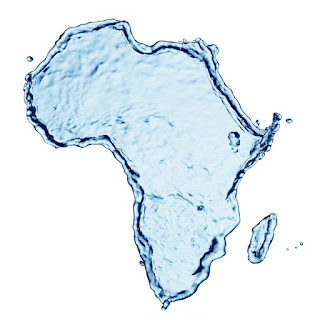Madagascar's Water Paradox
Land
in Madagascar next to river bank in drought prone zone
Among countries in Africa with complex water trends, Madagascar is a
case that is useful to address. This is mainly due to Madagascar’s intensifying
climate variability from environmental change, causing an increasing imbalance in
precipitation across the island and rising extreme weather events such as
flooding, cyclones and droughts. As you can see
on Figure 1, there is an
important difference in climatic conditions depending on the region in
Madagascar. On the Western and Southern parts, there is a higher mean annual
temperature than the Eastern coast, as well as around 2000-3000 mm less annual
precipitation in the Southern coast than the East. This gives rise to distinct
weather occurrences depending on the region.
Figure 1: Mean Annual temperature and mean annual precipitation in Madagascar obtained from the WorldClim database
Water scarcity
The region most affected by the case of water scarcity would be Southern Madagascar. Prolonged periods of water scarcity from recurrent low rainfall seasons there have led to the ‘Kere of Madagascar,’ one of the country’s most severe food crisis in the South. This has required substantial funds towards assisting the local population, with the recent investment from the US embassy of $25 million meant to mitigate food insecurity in the South, as well as more than $261 million already provided by the USAID. Now, why is this consistent below-average rate of rainfall occurring? It’s been argued by the World Weather Attribution that a combination of both vulnerability from underinvestment towards water collection facilities in an arid natural climate and the consequences of human activities intensifying the rate of desertification has brought this unusual case of water scarcity.
Water surplus
On the other hand, Eastern
Madagascar tends to undergo excessive rainfall, especially as this zone is
prone to cyclones. One recent example would be the emergence of Cyclone Emnati
and Cyclone Batsirai in 2022, involving 700,000 people and 14 regions in the
east coast of Madagascar. (Red Cross, 2022) Furthermore, the period of
January-March was economically devastating for Madagascar and its neighboring
countries, as Tropical storms Ana,
Dumako, and Gombe occurred in between these cyclones, estimating to an economic
loss of around $300 million in the Southeast Africa. This is also because in such a heavy period of precipitation, other
catastrophes are triggered, with the most notable one being landslides. The
capital Antananarivo, located in the Central-east of Madagascar, was
significantly affected from the aftermath of the January weather events, with
around 27,000 evacuated from their homes either due to landslides and flooding.
I strongly believe that
behind the issues of those distinct regions, the complications behind those
issues are the same, but that the outcomes are different due to the local
environmental change between the zones. First, the lack of efforts to
strengthen responses to abrupt climate
shocks and lack of adequate infrastructure in water drainage or collection.
Secondly, unsustainable human practices from deforestation by intensive
agricultural practices has significantly modified land structure and aggravated
climatic events, ranging from induced drought prone zones
to increasing soil erosion during high seasonal rainfall.




It was a really interesting chapter in your analysis of water paradoxes in Africa. Your writing highlighted the importance of extreme climate variability. I am wondering why there is this lack of attention towards climate adaptability in the country?
ReplyDeleteThank you for your comment! I think it is rather that inadequate measures towards climate adaptability that is the issue rather than a lack of attention
Delete